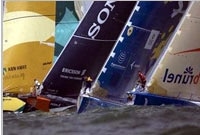
VolvoChanges
Purists were stunned after Glen Bourke, the Volvo Ocean Race’s current maestro, stood before the podium in Rotterdam last month and announced that the next edition of the longest running crewed around-the-world race, starting late in 2008, would call upon the Middle East, Asia, and the West Coast of the United States. As he made the announcement, you could hear the silence of pens wavering over notepads. The following day, however, more than a few sailing scribes embarked on their personal tirades, admonishing Bourke and Co., of selling out this beloved contest, of allowing blatant commercialism to gut the race of its spirit.At first, I didn’t know what to think. I had reservations: Asia? The Middle East? How? What about the Southern Ocean legs-what will we do without the stories and images that make this stretch of the race so compelling from the comfort of our computers? But I’ve come to terms with the new proposed format. Sure, the race will no longer have two brutal Southern Ocean legs, but so long as the racing is tactically good, and the boats are exciting, the ardent armchair sailor will fire up Virtual Spectator every morning to check in on the action, no matter where in the world it is taking place.The route itself has yet to be announced and the pressure to do so, post haste, is heaped squarely on Bourke’s team-they’ve stripped themselves of a year of preparation, so pulling this off will be no easy task. Teams need to know now where they’ll be sailing so they can run their weather studies and commence their hull and sail designs accordingly.In the meantime, let’s plan this one for them. With the race starting in the Mediterranean city of Alicante, Spain, and with the Middle East mostly likely on the docket, this would mean the opening leg would either be out to the Atlantic, or east across the Mediterranean, followed by a transit of the Suez Canal. Let’s hope Volvo has the sense to not allow the latter option. It would be a terrible way to start a round-the-world ocean race. A leg from deep within the Med to Cape Town would be much better. Although, we’ll surely miss the dramatic North Atlantic pasting the teams got last November on their first night at sea.After an in-port race in Cape Town, the fleet could lay tracks north to the United Arab Emirates. In Dubai, where wealth and sailing are both wholly embraced, we can count on the most opulent reception the race has ever seen. Sailing conditions on The Gulf are said to be superb, and the venue is ripe for an in-port race.After Dubai, the next destination for the 70s should be Melbourne, Australia, with a New York-style pit-stop in Singapore, Malaysia, along the way, if need be. The Melbourne stop is essential because it cements the race in at least one sailing-crazed Southern Hemisphere city. From Australia, it’s off to Hong Kong, with an in-port race there, and then to Japan (Yokohomo) for another.Naturally, an eastbound crossing lands them in San Francisco. There’s simply no better place in the States to host an in-port race. From there we’d look for a long haul, the longest leg of the race, a true test of endurance-around Cape Horn and north to Brazil. Sure it’s a marathon leg, but if Vendee Globe skippers can lap the world without stopping, then a fully-crewed 70 sailing at windspeed can deal with a few extra miles. From Brazil, the race would take its traditional stop in Baltimore and Annapolis. One way to shorten the Chesapeake stop would be to have the in-port race as a component of the start. Send them around the buoys, out of the Bay, up and around Ambrose Lighthouse (a scoring gate), and then across the Atlantic to France. Two U.S. stops are one too many, anyway. From France, there should be a pit-stop in Portsmouth and then up and around the English Isles to Holland, Germany, or Denmark (or all three). Numerous short legs in the end put lots of points on the table, which, as this past race proved, keeps thing interesting until the end. The finish, obviously, is in Sweden.Of course, this is all speculative, and there are many issues for Volvo to contend with, not the least of which is the race’s duration. Nine months was long for the last edition, and, says VOR’s press officer Lizzie Green, they [i.e. everyone involved] don’t want to drag it out any longer.Whatever route they decide, this change is good. With the ice gates implemented for the last race, the boats never really got into the heart of the Southern Ocean as they did in years past. And the boats were exciting enough in 20 knots to keep us all entertained. For the crews who’ve now done it several times, the change is welcome. The Volvo 60s of races past were getting predictable, four-timer Mark Christensen told me in Vigo last November, and so now is the “traditional route.” Several competitors I’ve spoken with in the past week have candidly supported the changes, fully acknowledging that the race needs sponsors in order to survive. Taking the race to fertile markets, especially those in Asia, is the price we all have to pay. So long as they’re having fun playing, I’m having fun spectating.









